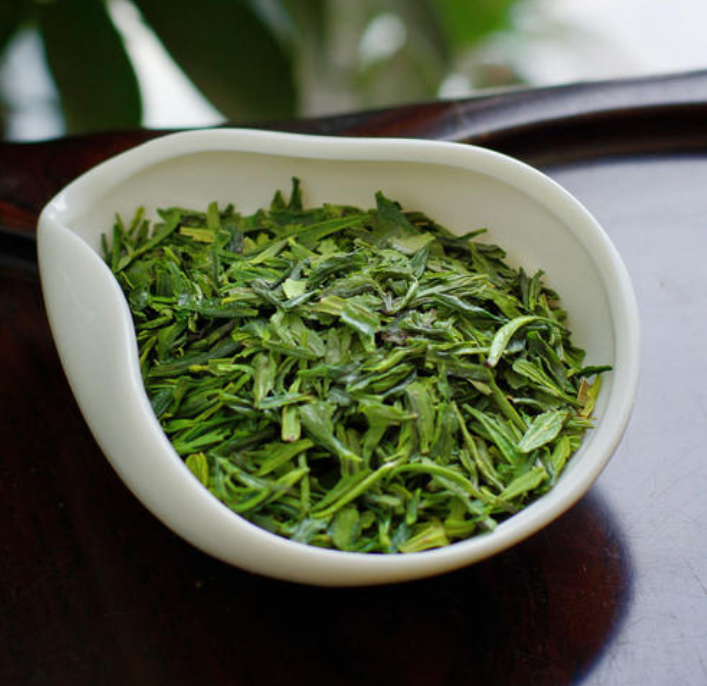Nestled in the mist-laden embrace of Jiulian Mountain in Wuhu, Anhui Province, emerges a tea that embodies the essence of eastern China’s serene landscapes: 九山碧毫 (Jiǔshān Bìháo), or “Nine Mountains Jade Down.” This emerald-hued green tea, celebrated for its delicate flavor and meticulous craftsmanship, has become a hallmark of the region’s tea culture since its development in the late 20th century.

A Legacy Rooted in Nature
The story of Jiushan Bihao begins in the 1980s when tea masters of Wuhu’s Bayu District sought to craft a beverage that captured the terroir of Jiulian Mountain—a range renowned for its cloud-kissed peaks, fertile red soils, and 1,200 mm of annual rainfall. The tea thrives in an eco-friendly paradise, where pesticide-free gardens yield leaves imbued with the mountain’s mineral-rich waters and crisp air. Today, it is produced in limited quantities, with batches often selling out pre-harvest due to its growing reputation.
Artistry in Every Leaf
Jiushan Bihao’s creation is a four-hour dance of fire and finesse:
- Plucking: Only the tenderest buds and one leaf are hand-selected in early spring, ensuring a yield of approximately 30,000 tips per kilogram.
- Withering: Fresh leaves are spread on bamboo trays under natural sunlight for 2–3 hours to reduce moisture gently.
- Fixation (杀青): Leaves are stir-fried in woks at 190–200°C, halting oxidation while preserving emerald hues and grassy freshness.
- Rolling: Mechanical rollers shape the leaves into slender strips, initiating enzymatic reactions that deepen flavor complexity.
- Hand Shaping: The defining stage involves three intricate steps:
- Threading: Gently twisting leaves into needle-like strands.
- Grinding: Polishing each strand to a satin finish using palm friction.
- Drying: Final roasting at 70°C locks in aroma and reduces moisture to 5%.
Aesthetic and Sensory Delight
The finished tea dazzles with its appearance: slender, jade-green strips adorned with silvery fuzz, resembling dew-kissed pine needles. Brewed at 75–80°C, it unfurls to reveal:
- Aroma: Fresh orchid and chestnut notes with a hint of seaweed.
- Liquor: Luminous yellow-green, crisp and viscous.
- Flavor: A symphony of sweetness and umami, balanced by a lingering chestnut finish.
- Leaves: Plump, emerald-green buds with intact silver tips.
Brewing Ritual
To honor its complexity:
- Use 2–3g of tea (1 tsp) per 150ml glass or porcelain vessel.
- Pre-warm the pot with 80°C water, discard, then add leaves.
- Infuse for 1–2 minutes, adjusting for subsequent brews.
- Observe the “dancing needles”—leaves that stand erect before settling gracefully.
Authenticity and Grading
Genuine Jiushan Bihao is distinguished by:
- Appearance: Uniform, slender needles without broken tips.
- Color: Vibrant jade-green hue (not dull or yellowed).
- Aroma: Fresh, not grassy or stale.
Grading follows strict standards:
- Supreme Grade: Entirely composed of silvery buds (≥45,000 tips/kg).
- Special Grade: One bud with a tender leaf (≥25,000 tips/kg).
- Premium Grade: One bud with two leaves.
Prices range from ¥600–¥1,200/500g for supreme grades, reflecting its labor intensity and limited yield (≈15kg per mu annually).
Healthful Elixir
Rich in catechins (28–34%) and L-theanine, Jiushan Bihao offers:
- Antioxidant defense against free radicals.
- Metabolic support, aiding weight management.
- Mental clarity, with 25–35mg caffeine per cup.
- Oral health benefits, inhibiting plaque bacteria.
Legacy and Contemporary Reverence
Jiushan Bihao transcends its role as a beverage—it is a cultural artifact. The Wuhu Tea Museum preserves 1980s processing tools, while annual “Jade Down Festivals” celebrate harvests with traditional folk performances. As climate-resilient cultivars emerge, this tea remains a testament to Anhui’s agrarian heritage, its needle-like leaves piercing through time to delight modern palates.
In every sip, one tastes not just tea, but the mist of Nine Mountains, the patience of generations, and the enduring spirit of China’s tea masters.



